Fei Xue
MATCHA:Towards Matching Anything
Jan 24, 2025



Abstract:Establishing correspondences across images is a fundamental challenge in computer vision, underpinning tasks like Structure-from-Motion, image editing, and point tracking. Traditional methods are often specialized for specific correspondence types, geometric, semantic, or temporal, whereas humans naturally identify alignments across these domains. Inspired by this flexibility, we propose MATCHA, a unified feature model designed to ``rule them all'', establishing robust correspondences across diverse matching tasks. Building on insights that diffusion model features can encode multiple correspondence types, MATCHA augments this capacity by dynamically fusing high-level semantic and low-level geometric features through an attention-based module, creating expressive, versatile, and robust features. Additionally, MATCHA integrates object-level features from DINOv2 to further boost generalization, enabling a single feature capable of matching anything. Extensive experiments validate that MATCHA consistently surpasses state-of-the-art methods across geometric, semantic, and temporal matching tasks, setting a new foundation for a unified approach for the fundamental correspondence problem in computer vision. To the best of our knowledge, MATCHA is the first approach that is able to effectively tackle diverse matching tasks with a single unified feature.
VRS-NeRF: Visual Relocalization with Sparse Neural Radiance Field
Apr 14, 2024



Abstract:Visual relocalization is a key technique to autonomous driving, robotics, and virtual/augmented reality. After decades of explorations, absolute pose regression (APR), scene coordinate regression (SCR), and hierarchical methods (HMs) have become the most popular frameworks. However, in spite of high efficiency, APRs and SCRs have limited accuracy especially in large-scale outdoor scenes; HMs are accurate but need to store a large number of 2D descriptors for matching, resulting in poor efficiency. In this paper, we propose an efficient and accurate framework, called VRS-NeRF, for visual relocalization with sparse neural radiance field. Precisely, we introduce an explicit geometric map (EGM) for 3D map representation and an implicit learning map (ILM) for sparse patches rendering. In this localization process, EGP provides priors of spare 2D points and ILM utilizes these sparse points to render patches with sparse NeRFs for matching. This allows us to discard a large number of 2D descriptors so as to reduce the map size. Moreover, rendering patches only for useful points rather than all pixels in the whole image reduces the rendering time significantly. This framework inherits the accuracy of HMs and discards their low efficiency. Experiments on 7Scenes, CambridgeLandmarks, and Aachen datasets show that our method gives much better accuracy than APRs and SCRs, and close performance to HMs but is much more efficient.
PRAM: Place Recognition Anywhere Model for Efficient Visual Localization
Apr 11, 2024



Abstract:Humans localize themselves efficiently in known environments by first recognizing landmarks defined on certain objects and their spatial relationships, and then verifying the location by aligning detailed structures of recognized objects with those in the memory. Inspired by this, we propose the place recognition anywhere model (PRAM) to perform visual localization as efficiently as humans do. PRAM consists of two main components - recognition and registration. In detail, first of all, a self-supervised map-centric landmark definition strategy is adopted, making places in either indoor or outdoor scenes act as unique landmarks. Then, sparse keypoints extracted from images, are utilized as the input to a transformer-based deep neural network for landmark recognition; these keypoints enable PRAM to recognize hundreds of landmarks with high time and memory efficiency. Keypoints along with recognized landmark labels are further used for registration between query images and the 3D landmark map. Different from previous hierarchical methods, PRAM discards global and local descriptors, and reduces over 90% storage. Since PRAM utilizes recognition and landmark-wise verification to replace global reference search and exhaustive matching respectively, it runs 2.4 times faster than prior state-of-the-art approaches. Moreover, PRAM opens new directions for visual localization including multi-modality localization, map-centric feature learning, and hierarchical scene coordinate regression.
Individualized Dynamic Model for Multi-resolutional Data
Nov 22, 2023



Abstract:Mobile health has emerged as a major success in tracking individual health status, due to the popularity and power of smartphones and wearable devices. This has also brought great challenges in handling heterogeneous, multi-resolution data which arise ubiquitously in mobile health due to irregular multivariate measurements collected from individuals. In this paper, we propose an individualized dynamic latent factor model for irregular multi-resolution time series data to interpolate unsampled measurements of time series with low resolution. One major advantage of the proposed method is the capability to integrate multiple irregular time series and multiple subjects by mapping the multi-resolution data to the latent space. In addition, the proposed individualized dynamic latent factor model is applicable to capturing heterogeneous longitudinal information through individualized dynamic latent factors. In theory, we provide the integrated interpolation error bound of the proposed estimator and derive the convergence rate with B-spline approximation methods. Both the simulation studies and the application to smartwatch data demonstrate the superior performance of the proposed method compared to existing methods.
IMP: Iterative Matching and Pose Estimation with Adaptive Pooling
Apr 28, 2023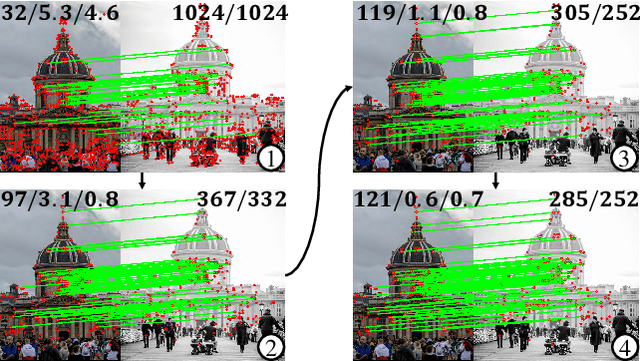
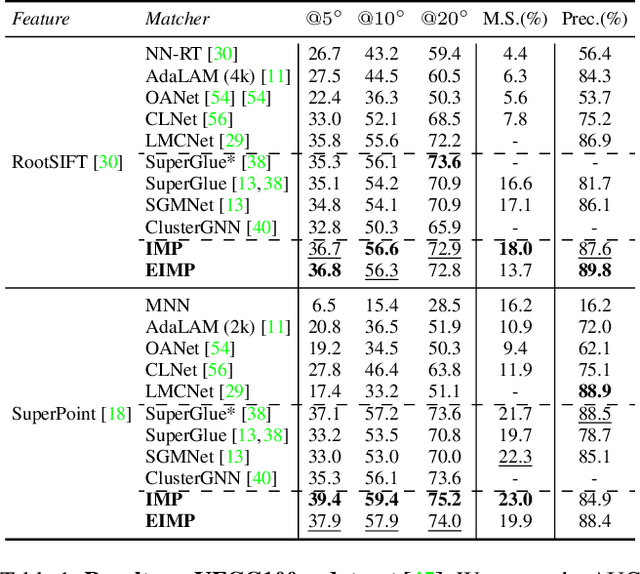

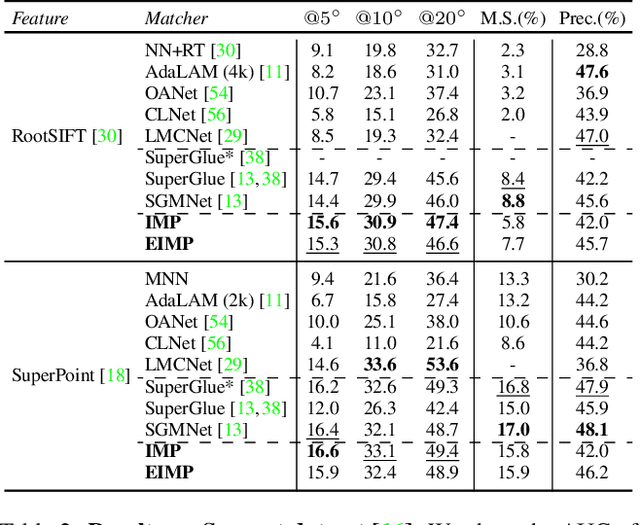
Abstract:Previous methods solve feature matching and pose estimation using a two-stage process by first finding matches and then estimating the pose. As they ignore the geometric relationships between the two tasks, they focus on either improving the quality of matches or filtering potential outliers, leading to limited efficiency or accuracy. In contrast, we propose an iterative matching and pose estimation framework (IMP) leveraging the geometric connections between the two tasks: a few good matches are enough for a roughly accurate pose estimation; a roughly accurate pose can be used to guide the matching by providing geometric constraints. To this end, we implement a geometry-aware recurrent attention-based module which jointly outputs sparse matches and camera poses. Specifically, for each iteration, we first implicitly embed geometric information into the module via a pose-consistency loss, allowing it to predict geometry-aware matches progressively. Second, we introduce an \textbf{e}fficient IMP, called EIMP, to dynamically discard keypoints without potential matches, avoiding redundant updating and significantly reducing the quadratic time complexity of attention computation in transformers. Experiments on YFCC100m, Scannet, and Aachen Day-Night datasets demonstrate that the proposed method outperforms previous approaches in terms of accuracy and efficiency.
SFD2: Semantic-guided Feature Detection and Description
Apr 28, 2023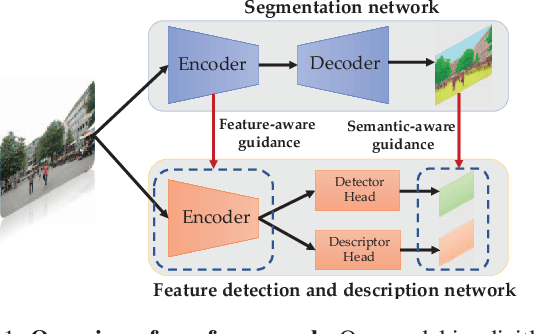

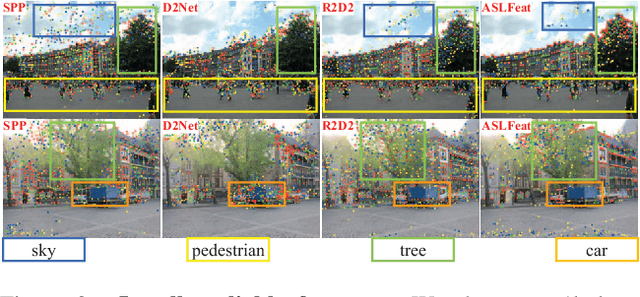
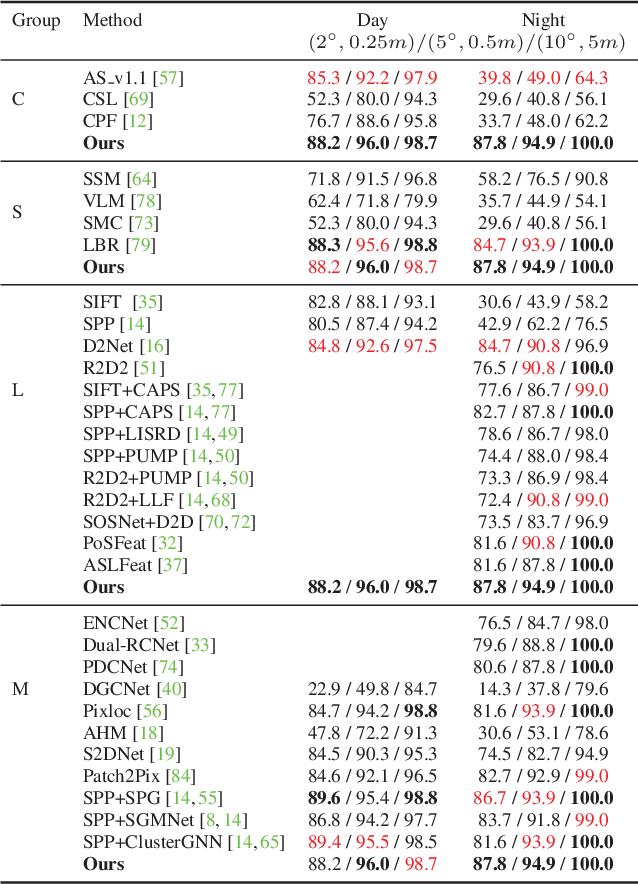
Abstract:Visual localization is a fundamental task for various applications including autonomous driving and robotics. Prior methods focus on extracting large amounts of often redundant locally reliable features, resulting in limited efficiency and accuracy, especially in large-scale environments under challenging conditions. Instead, we propose to extract globally reliable features by implicitly embedding high-level semantics into both the detection and description processes. Specifically, our semantic-aware detector is able to detect keypoints from reliable regions (e.g. building, traffic lane) and suppress unreliable areas (e.g. sky, car) implicitly instead of relying on explicit semantic labels. This boosts the accuracy of keypoint matching by reducing the number of features sensitive to appearance changes and avoiding the need of additional segmentation networks at test time. Moreover, our descriptors are augmented with semantics and have stronger discriminative ability, providing more inliers at test time. Particularly, experiments on long-term large-scale visual localization Aachen Day-Night and RobotCar-Seasons datasets demonstrate that our model outperforms previous local features and gives competitive accuracy to advanced matchers but is about 2 and 3 times faster when using 2k and 4k keypoints, respectively.
Semi-Supervised Statistical Inference for High-Dimensional Linear Regression with Blockwise Missing Data
Jun 07, 2021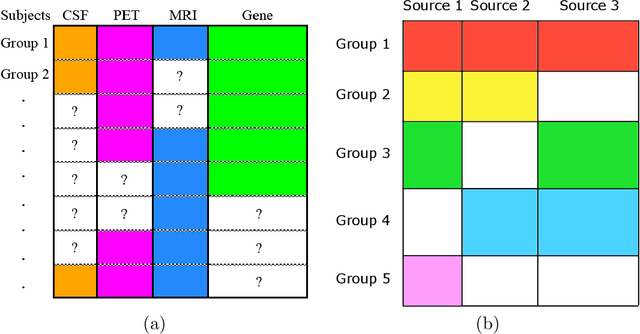

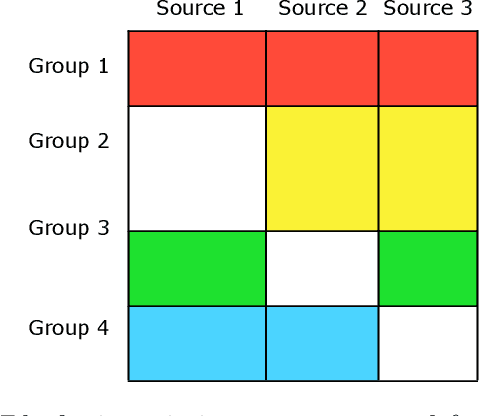

Abstract:Blockwise missing data occurs frequently when we integrate multisource or multimodality data where different sources or modalities contain complementary information. In this paper, we consider a high-dimensional linear regression model with blockwise missing covariates and a partially observed response variable. Under this semi-supervised framework, we propose a computationally efficient estimator for the regression coefficient vector based on carefully constructed unbiased estimating equations and a multiple blockwise imputation procedure, and obtain its rates of convergence. Furthermore, building upon an innovative semi-supervised projected estimating equation technique that intrinsically achieves bias-correction of the initial estimator, we propose nearly unbiased estimators for the individual regression coefficients that are asymptotically normally distributed under mild conditions. By carefully analyzing these debiased estimators, asymptotically valid confidence intervals and statistical tests about each regression coefficient are constructed. Numerical studies and application analysis of the Alzheimer's Disease Neuroimaging Initiative data show that the proposed method performs better and benefits more from unsupervised samples than existing methods.
Active Terahertz Imaging Dataset for Concealed Object Detection
May 08, 2021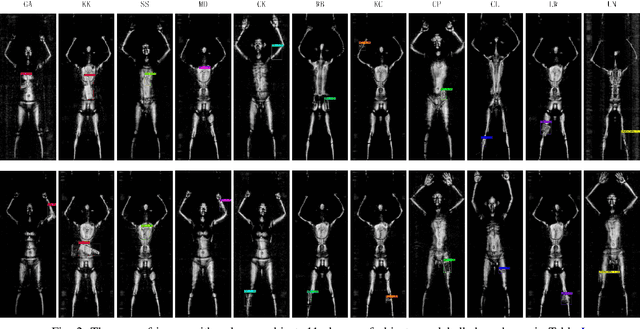
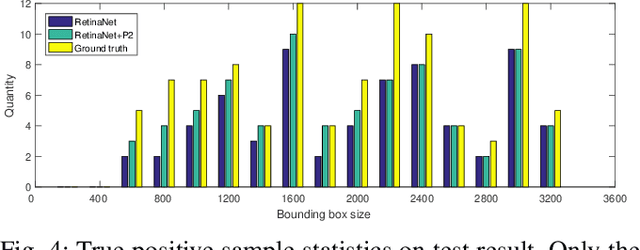


Abstract:Concealed object detection in Terahertz imaging is an urgent need for public security and counter-terrorism. In this paper, we provide a public dataset for evaluating multi-object detection algorithms in active Terahertz imaging resolution 5 mm by 5 mm. To the best of our knowledge, this is the first public Terahertz imaging dataset prepared to evaluate object detection algorithms. Object detection on this dataset is much more difficult than on those standard public object detection datasets due to its inferior imaging quality. Facing the problem of imbalanced samples in object detection and hard training samples, we evaluate four popular detectors: YOLOv3, YOLOv4, FRCN-OHEM, and RetinaNet on this dataset. Experimental results indicate that the RetinaNet achieves the highest mAP. In addition, we demonstrate that hiding objects in different parts of the human body affect detection accuracy. The dataset is available at https://github.com/LingLIx/THz_Dataset.
Line Flow based SLAM
Sep 21, 2020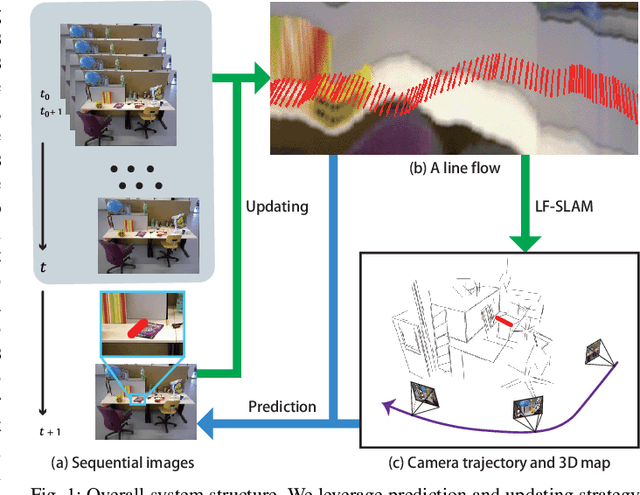
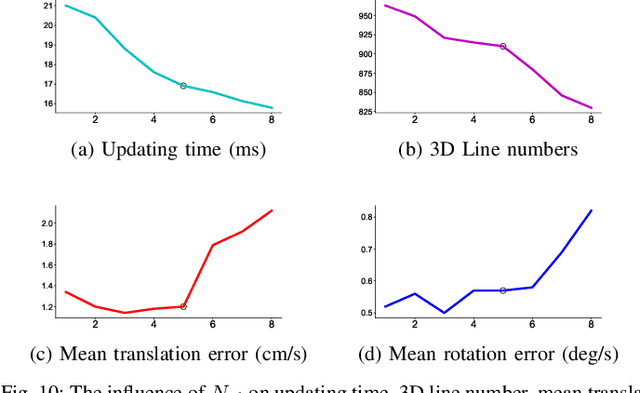
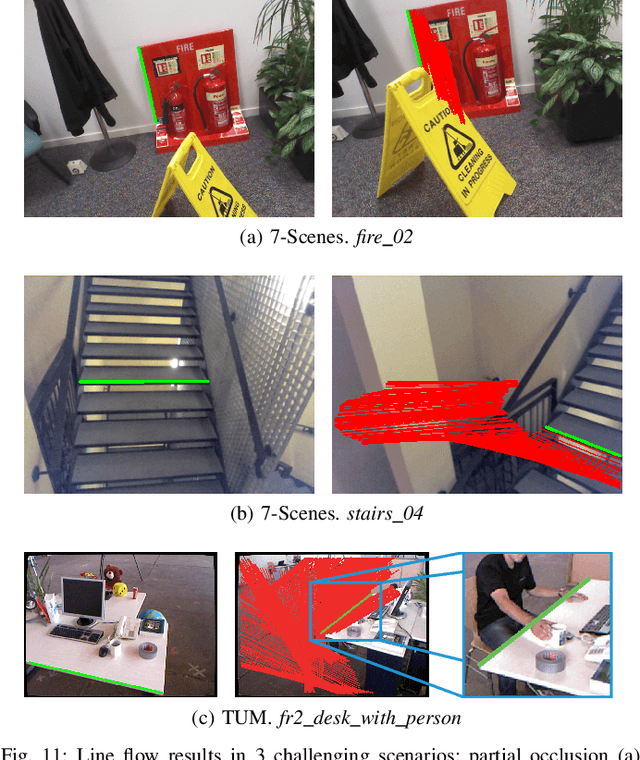
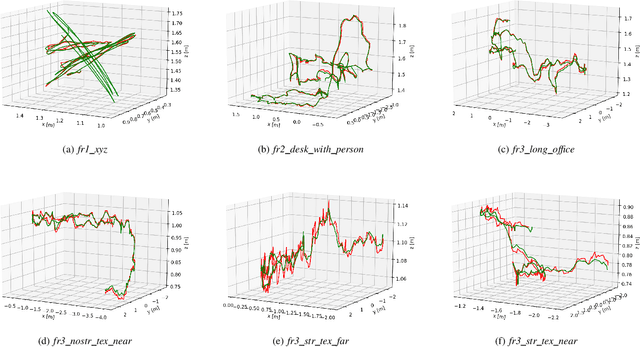
Abstract:We propose a method of visual SLAM by predicting and updating line flows that represent sequential 2D projections of 3D line segments. While indirect SLAM methods using points and line segments have achieved excellent results, they still face problems in challenging scenarios such as occlusions, image blur, and repetitive textures. To deal with these problems, we leverage line flows which encode the coherence of 2D and 3D line segments in spatial and temporal domains as the sequence of all the 2D line segments corresponding to a specific 3D line segment. Thanks to the line flow representation, the corresponding 2D line segment in a new frame can be predicted based on 2D and 3D line segment motions. We create, update, merge, and discard line flows on-the-fly. We model our Line Flow-based SLAM (LF-SLAM) using a Bayesian network. We perform short-term optimization in front-end, and long-term optimization in back-end. The constraints introduced in line flows improve the performance of our LF-SLAM. Extensive experimental results demonstrate that our method achieves better performance than state-of-the-art direct and indirect SLAM approaches. Specifically, it obtains good localization and mapping results in challenging scenes with occlusions, image blur, and repetitive textures.
Deep Visual Odometry with Adaptive Memory
Aug 02, 2020Abstract:We propose a novel deep visual odometry (VO) method that considers global information by selecting memory and refining poses. Existing learning-based methods take the VO task as a pure tracking problem via recovering camera poses from image snippets, leading to severe error accumulation. Global information is crucial for alleviating accumulated errors. However, it is challenging to effectively preserve such information for end-to-end systems. To deal with this challenge, we design an adaptive memory module, which progressively and adaptively saves the information from local to global in a neural analogue of memory, enabling our system to process long-term dependency. Benefiting from global information in the memory, previous results are further refined by an additional refining module. With the guidance of previous outputs, we adopt a spatial-temporal attention to select features for each view based on the co-visibility in feature domain. Specifically, our architecture consisting of Tracking, Remembering and Refining modules works beyond tracking. Experiments on the KITTI and TUM-RGBD datasets demonstrate that our approach outperforms state-of-the-art methods by large margins and produces competitive results against classic approaches in regular scenes. Moreover, our model achieves outstanding performance in challenging scenarios such as texture-less regions and abrupt motions, where classic algorithms tend to fail.
 Add to Chrome
Add to Chrome Add to Firefox
Add to Firefox Add to Edge
Add to Edge